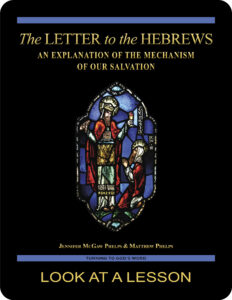faith & hope
 In the eleventh chapter of the Letter to the Hebrews (NABRE), we encounter a familiar statement about faith that is often cited as a definition: “Faith is the realization of what is hoped for and evidence of things not seen.” This statement offers significant insight into faith and its relationship to hope, but in order to grasp that insight, it’s helpful to have a basic understanding of the concepts of faith and hope.
In the eleventh chapter of the Letter to the Hebrews (NABRE), we encounter a familiar statement about faith that is often cited as a definition: “Faith is the realization of what is hoped for and evidence of things not seen.” This statement offers significant insight into faith and its relationship to hope, but in order to grasp that insight, it’s helpful to have a basic understanding of the concepts of faith and hope.
The Greek word translated as faith, πίστις (pistis), means “trust”. We often look at faith as an act of belief or intellectual assent, but at its heart faith is much deeper than that. It’s absolute trust in God. The Greek word for hope, elpis ἐλπίς (elpis), means expectation. Hope rooted in expectation is very different from the connotation of wishing that often accompanies the word. If I hope—wish—I’ll win the lottery, I’m still going to work the day after I buy my ticket. If I hope—expect—I’ll win the lottery, I’ll buy my ticket and quit my job even before the drawing. Hope as expectation is what is asked of Christians, though it can be hard to place such expectation in God. That’s where faith comes into play.
With that in mind, we’ll return to our passage. Faith is the substance or foundation of the things we hope for. This statement conveys a profound truth about the relationship between faith and hope. Our trust in God shapes our expectations. As Abraham trusted God’s promise, so he also acted based on what he expected would happen. It’s the expectation formed from trusting God that shapes and changes our behavior. Faith serves as the means by which we can act in contradiction to our senses—it serves as proof even when our senses cannot. In dealing with an invisible God, faith is absolutely essential.
The Litany of Trust is a related prayer written by the Sisters of Life (www.sistersoflife.org) asking Jesus for deliverance from the things that hold us bound, and placing our trust in Jesus’ promises.
you also may like our study of the Letter to the Hebrews (digital only)
 Many Christians struggle to understand one of the central mysteries of our faith: how Jesus can be both human and divine at the same time. The Letter to the Hebrews: An Explanation of the Mechanism of Our Salvation, an 18-lesson Catholic Bible study with an imprimatur, offers an in-depth look at the way in which Jesus’ dual nature allows for the salvation of humanity. The Letter to the Hebrews is designed to provide information that will encourage Christians to remain faithful. Click on the book’s cover to view a sample lesson.
Many Christians struggle to understand one of the central mysteries of our faith: how Jesus can be both human and divine at the same time. The Letter to the Hebrews: An Explanation of the Mechanism of Our Salvation, an 18-lesson Catholic Bible study with an imprimatur, offers an in-depth look at the way in which Jesus’ dual nature allows for the salvation of humanity. The Letter to the Hebrews is designed to provide information that will encourage Christians to remain faithful. Click on the book’s cover to view a sample lesson.
 Click on the picture of the statue of Moses with horns (above) to learn more about Lost in Translation. A new entry is archived each Monday. Contact us to receive Lost in Translation by email every week. You may use any of the contact links on our website to ask Matthew a question.
Click on the picture of the statue of Moses with horns (above) to learn more about Lost in Translation. A new entry is archived each Monday. Contact us to receive Lost in Translation by email every week. You may use any of the contact links on our website to ask Matthew a question.
